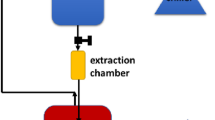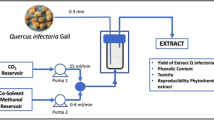Abstract
Nowadays supercritical CO2 extracts of cinnamon and cassia are coming more and more in trade. Contrary to cinnamon and cassia oils there are very few references in literature about these. Commercially available supercritical CO2 extracts of cinnamon and cassia barks (cinnamon type Ceylon and type Madagascar, cassia type China and type Indonesia) were analysed by HPLC and compared with cinnamon and cassia oils. The results of the analysis showed that the main compounds evidently differed depending on the species of cinnamon (Cinnamomum zeylanicum, C. cassia andC. burmanii) and on the kind of sample, whereby there was a great difference not only between oils and CO2 extracts, but also between so-called „selective extracts“ (40°C/90 bar) and „total extracts“ (40°/280–300 bar).
Zusammenfassung
Über Zimthochdruckextrakte, die neuerdings zunehmend im Handel anzutreffen sind, liegen im Gegensatz zu Zimtölen bisher fast keine Literaturangaben vor. Mittels HPLC wurden daher handelsübliche Zimtrinden-CO2-Hochdruckextrakte vonCinnamomum zeylanicum (Ceylon- und Madagaskar-Zimt),C. cassia (Chinesischer Zimt) undC. burmanii (Padang-Zimt) im Vergleich mit Zimtölen untersucht. Dabei zeigte sich, daß die relevanten Inhaltsstoffe abhängig von der Zimtart einerseits und der Probenart andererseits in unterschiedlichen, charakteristischen Konzentrationen vorlagen, wobei sich nicht nur Öle und Hochdruckextrakte, sondern auch sog. „Selektivextrakte“ (40°C/90 bar) und „Totalextrakte“ (40°C/ 280–300 bar) deutlich voneinander unterschieden.
Similar content being viewed by others
Literatur
Melchior H, Kastner H (1974) Gewürze, botanische und chemische Untersuchung. Parey, Berlin, S 175–176
Heath HB (1981) Source book of flavors. Avi, Westport, S 233–236
Deutsches Arzneibuch, 10. Ausgabe (1991) mit 1. Nachtrag (1992) Deutscher Apothekerverlag, Stuttgart
Handbuch der Lebensmittelchemie (1970) Bd. VI. Springer, Berlin Heidelberg New York, S 448–464
Wijesekera ROB (1978) Crit Revs Food Sci Nut 10: 1–30
International Standard ISO 6539-1983 (E)
International Standard ISO 6538-1982 (E)
Zander (1993) Handwörterbuch der Pflanzennamen. Ulmer, Stuttgart
Norman J (1991) Das große Buch der Gewürze. AT Aarau, Stuttgart, S 30
Wijesekera ROB, Jayewardene AL, Rajapakse LS (1974) J Sci Food Agric 25: 1211–1220
Vernin C et al (1990) Parfums, cosmétiques, arômes 93: 85–90
Ross MSF (1976) J Chromatogr 118: 273–275
Gildemeister E, Hoffmann F (1959) Die ätherischen Öle. Akademie Verlag, Berlin, S 2–21
Quirin KW, Gerard D (1987) Scifen, Öle, Fette, Wachse 113: 539–544
Quirin KW, Gerard D, Kraus J (1986) Gordian 9: 156–159
Stahl E, Quirin KW, Gerard D (1987) Verdichtete Gase zur Extraktion und Raffination. Springer, Berlin Heidelberg New York
Mitteilung der Fa. Flavex Naturextrakte GmbH Rehlingen (1993/ 94)
Tateo F, Chizzini F (1989) J Ess Oil Res 1: 165–168
Cikalo MJ, Poole SK, Poole CF (1992) J Plan Chrom 5: 135–138
Archer AW (1988) J Chromatogr 447: 272–276
Zürcher K, Hadorn H, Strack Ch (1974) Mitt Gebiete Lebensm Hyg 65: 440–452
Senanayake UM, Lee TH, Wills RBH (1978) J Agric Food Chem 26: 822–824
Stahl E, Schild W (1981) Pharmazeutische Biologie. Fischer, Stuttgart, S 20–22
Macholz R, Lewerenz HJ (1989) Lebensmitteltoxikologie. Springer, Berlin Heidelberg New York, S 233–234
Teuscher E, Lindequist U (1987) Biogene Gifte. Fischer, Stuttgart New York, S 228–229
Author information
Authors and Affiliations
Rights and permissions
About this article
Cite this article
Ehlers, D., Hilmer, S. & Bartholomae, S. Hochdruckflüssigchromatographische Untersuchung von Zimt-CO2-Hochdruckextrakten im Vergleich mit Zimtölen. Z Lebensm Unters Forch 200, 282–288 (1995). https://doi.org/10.1007/BF01187520
Received:
Revised:
Issue Date:
DOI: https://doi.org/10.1007/BF01187520




